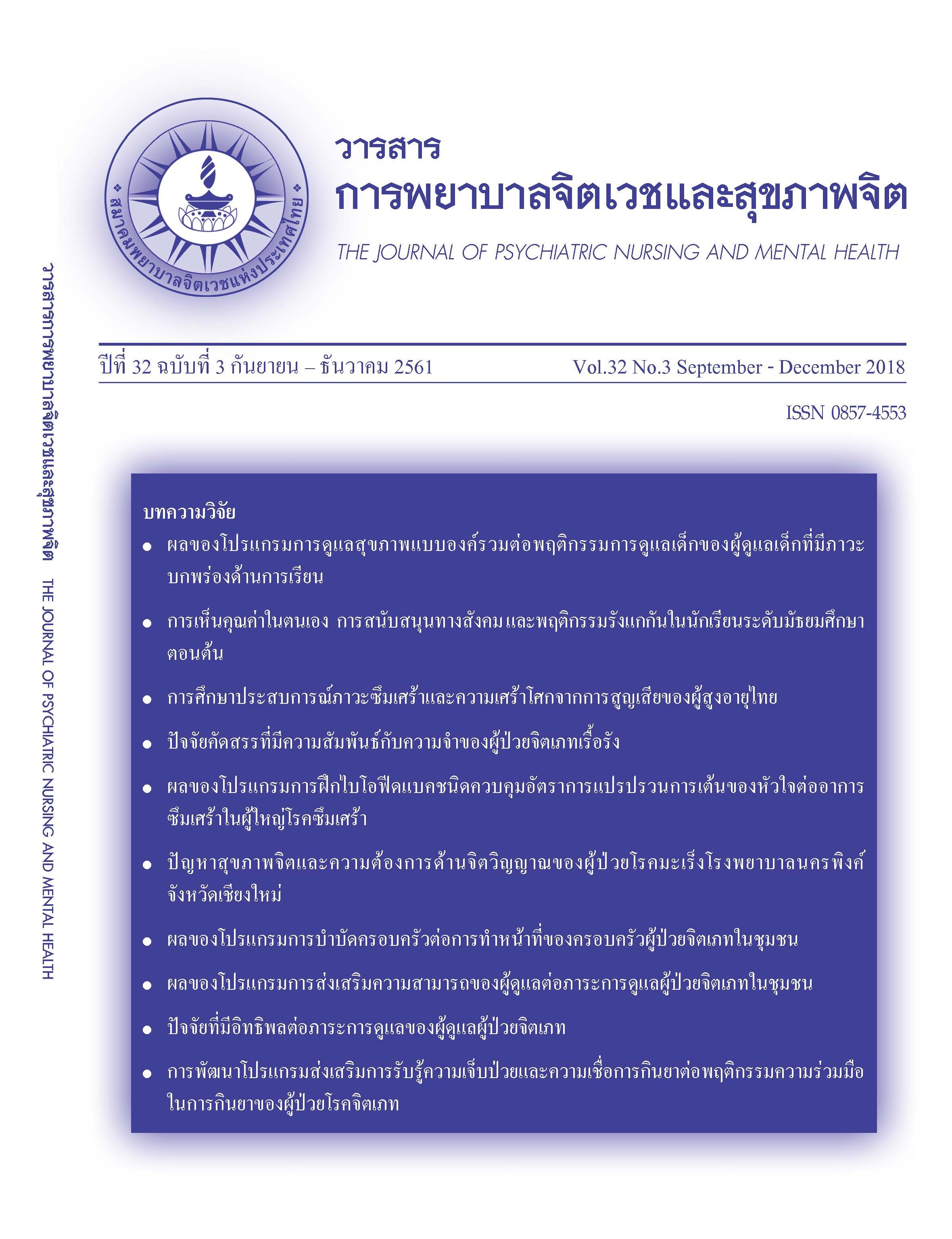ผลของโปรแกรมการฝึกไบโอฟีดแบคชนิดควบคุมอัตราการแปรปรวนการเต้นของหัวใจต่ออาการซึมเศร้าในผู้ใหญ่โรคซึมเศร้า
Main Article Content
บทคัดย่อ
บทคัดย่อ
วัตถุประสงค์: เพื่อศึกษาผลของโปรแกรมการฝึก HRV ไบโอฟีดแบค ต่ออาการซึมเศร้าในผู้ใหญ่โรคซึมเศร้า
วิธีการศึกษา: กลุ่มตัวอย่างของการวิจัยกึ่งทดลองนี้ คือ กลุ่มผู้ป่วยโรคซึมเศร้าวัยผู้ใหญ่ที่มารับการรักษาที่โรงพยาบาลชุมชน ในจังหวัดลพบุรี อายุระหว่าง 20 - 59 ปี จำนวน 66 รายสุ่มเข้ากลุ่มทดลองและกลุ่มควบคุม กลุ่มละ 33 ราย กลุ่มทดลองได้รับโปรแกรมการฝึก HRV ไบโอฟีดแบคร่วมกับการดูแลตามปกติ โปรแกรมการฝึกมีจำนวน 10 ครั้ง ครั้งละ 60-90 นาที สัปดาห์ละ 2 ครั้งต่อเนื่อง 5 สัปดาห์และมีการฝึกหายใจที่บ้านทุกวันอย่างน้อย 20 นาทีติดต่อกันสำหรับกลุ่มควบคุมได้รับการดูแลตามปกติเก็บข้อมูลก่อนและหลังการทดลองโดยใช้แบบประเมินภาวะซึมเศร้าของเบค (Beck Depression Inventory; BDI) วิเคราะห์โดยใช้สถิติพรรณนา,dependent t-test และ independent t-test ผลการศึกษา: ค่าเฉลี่ยคะแนนอาการซึมเศร้าภายหลังจากได้รับการฝึก HRV ไบโอฟีดแบคลดลงอย่างมีนัยสำคัญทางสถิติ (t =12.15, p <.001) และผลต่างของค่าเฉลี่ยคะแนนอาการซึมเศร้าก่อนและหลังได้รับโปรแกรมการฝึก HRV ไบโอฟีดแบคระหว่างสองกลุ่มมีความแตกต่างกันอย่างมีนัยสำคัญทางสถิติ (t =13.42, p<.001)
สรุป: โปรแกรมการฝึก HRV ไบโอฟีดแบคมีประสิทธิผลในการลดอาการซึมเศร้าในผู้ใหญ่โรคซึมเศร้า ดังนั้นจึงควรนำโปรแกรมการฝึกHRV ไบโอฟีดแบค มาประยุกต์ในการลดอาการซึมเศร้าของผู้ป่วยวัยผู้ใหญ่ในคลินิกเนื่องจากการบำบัดใช้เวลาสั้น และไม่ยุ่งยาก
Article Details
บทความที่ได้รับการตีพิมพ์แล้ว เป็นลิขสิทธิ์ของสมาคมพยาบาลจิตเวชแห่งประเทศไทย
เอกสารอ้างอิง
กรมสุขภาพจิต. (2555). ข้อมูลสถิติ. เข้าถึงเมื่อ 20 มกราคม 2557, จาก https://www.dmh.go.th./report/ population/pop.asp
ธรณินทร์ กองสุข และคณะ. (2549). การประเมิน โรคซึมเศร้า: การทบทวนหลักฐานทางวิชาการ.อุบลราชธานี: ศิริธรรมออฟเซ็ท.
ธวัชชัย กฤษณะประกรกิจ, สมจิตร์ หร่องบุตรศรี, และผ่องพรรณ กฤษณะประกรกิจ. (2552). สมาธิบำบัดทางจิตเวชศาสตร์และ สุขภาพจิต. ขอนแก่น: มหาวิทยาลัยขอนแก่น.
ธวัชชัย ลีฬหานาจ. (2552). โรคซึมเศร้าที่ดื้อต่อการรักษา. กรุงเทพมหานคร: บียอนด์ เอ็นเทอร์ไพรซ์.
มรรยาท เจริญสุขโสภณ และ นงลักษณ์ เชษฐภักดีจิต. (2537). รายงานวิจัย ศึกษา กระบวนการสรร้างสัมพันธภาพระดับความหวัง ความวิตกกังวล ความซึมเศร้า และระดับการดูแลตนเองของผู้ป่วยสูญเสีย อวัยวะ โรงพยาบาลชลบุรี.ชลบุรี: วิทยาลัยพยาบาลชลบุรี.
มรรยาท รุจิวิชชญ์. (2556). การจัดการความเครียดเพื่อเสริมสร้างสุขภาพจิต (พิมพ์ครั้งที่ 2). ปทุมธานี: โรงพิมพ์มหาวิทยาลัยธรรมศาสตร์.
สายฝน เอกวรางกูร. (2554). รู้จัก เข้าใจ ดูแล ภาวะซึมเศร้า. กรุงเทพมหานคร: สำนักพิมพ์แห่งจุฬาลงกรณ์มหาวิทยาลัย.
Beck, A. T. (1991). Cognitive therapy: A 30-year retrospective. American Psychology, 46(1), 368 – 375.
Beck, A.T., Ward, C. H., Mendelson, M., Mock, J., & Erbaugh, J. (1961) An inventory for measuring depression. Archives of General Psychiatry, 4, 561-571.
Bernardi, L., Passino, C., Wilmerding, V., Dallam, G. M., Parker, D. L., Robergs, R. A., et al. (2001). Breathing patterns and cardiovascular autonomic modulation during hypoxia induced by simulated altitude. Journal of Hypertension, 19, 947–958.
Bunthumporn, N. (2012). Effects of biofeedback training on negative affect, depressive cognitions, resourceful behaviors, and depressive symptoms in Thai elders. Unpublished doctoral thesis, Case Western Reserve University.
Cohen, J. (1992). Quantitative method in psychology: A power primer. Psychological Bulletin, 112 (1), 155-159.
Chung, L. J., Tsai, P. S., Liu, B. Y., Chou, K. R., Lin, W. K., Shyu, Y. K., et al. (2010). Home-based deep breathing for depression in patients with coronary heart disease: A randomized controlled trial. International Journal of Nursing Studies, 47, 1346-1353.
Deepak, D., Sinha, A., Gusain, V., & Goel, A. (2012). Study on effects of meditation on Sympathetic Nervous System functional status in meditators. Journal of Clinical and Diagnostic Research, 6(6), 938-942.
Karavidas, M., Lehrer, P.M., Vaschillo, E., Vaschillo, B., Marin, H., Malinovsky, I., et al. (2007). Preliminary results of an open label study of heart rate variability Biofeedback for the treatment of major depression. Applied Psychophysiology and Biofeedback, 32(10), 19-30.
Lehrer, P. M., Vaschillo, E., Vaschillo, B., Lu, S., Eckberg, D. L., Edelberg, R., et al. (2003). Heart rate variability biofeedback increases baroreflex gain and peak expiratory flow. Psychosomatic Medicine, 65(1), 796–805.
Muench, F. (2008). The Portable stress eraser heart rate variability biofeedback device: Background and research. Biofeedback, 36(1), 35–39.
Siepmann, M., Aykac, V., Unterdorfer, J., Petrowski, K., & Mueck-Weymann, M. (2008). A pilot study on the effects of heart rate variability biofeedback in patients with depression and in healthy subjects. Applied Psychophysiology and Biofeedback, 33(4), 195-201. doi:10.1007/s10484-008- 9064-z
Stein, P. K., Carney, R. M., Freedland, K. E., Skala, J. A., Jaffe, A. S., Kleiger, R. E., et al. (2000). Severe depression is associated with markedly reduced heart rate variability in patients with stable coronary heart disease. Journal of Psychosomatic Research, 48(5), 493-500.
Weissman, M. M. (1987). Advance in psychiatric epidemiology: Rates and risks for major depression. American Journal of Public Health, 77(4), 445-451.
World Health Organization. (1994). ICD 10 International Statistical Classification of disease and Related Health Problem (Ten Revision). Jeneva, Switzerland: World Health Organization.


